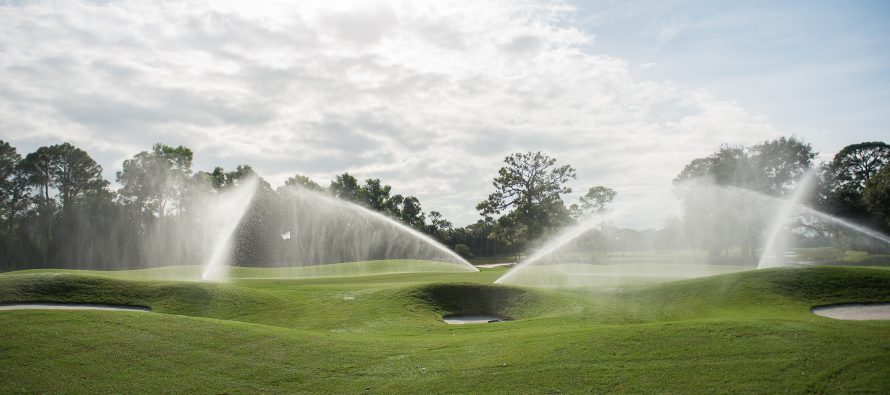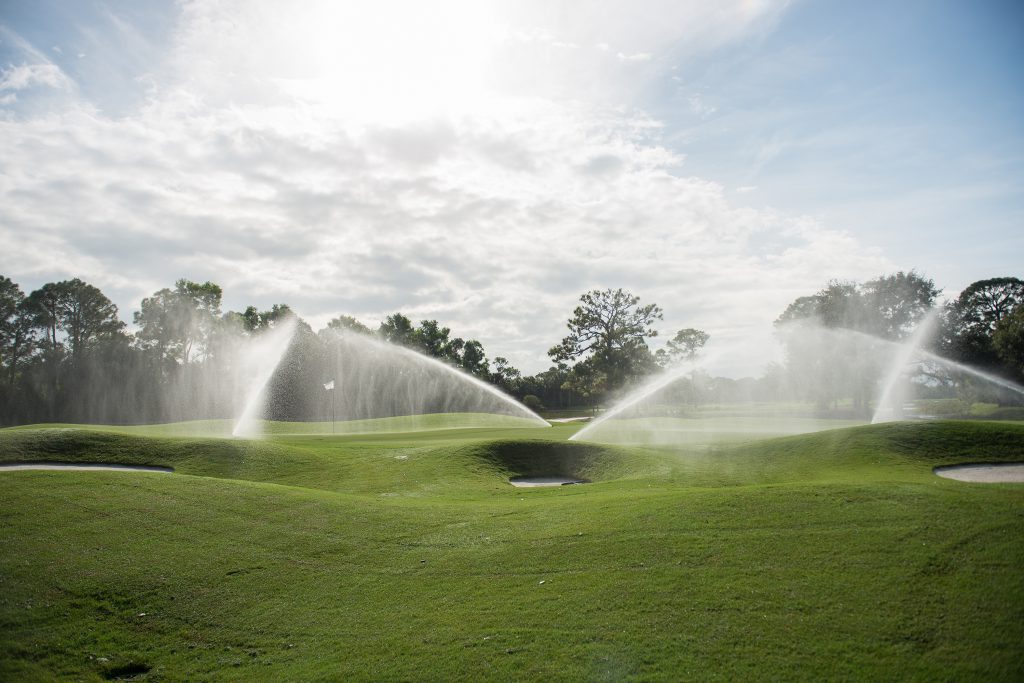What do we do about irrigation if there’s another heatwave?

Related Articles
Following lessons learnt from last year’s record summer heatwave, Peter Robin looks at practical ways of improving irrigation uniformity and water coverage.
Many golf courses and sports clubs in the UK have irrigation systems that just can’t quite manage to keep up with the dry weather conditions we experienced last summer. If we have a repeat this year and the budget is available for a new irrigation system – all well and good – but what options are available to prevent a long summer behind the hand-hose?
Assuming you have an in-ground irrigation system, which is leaving you with a whole lot of dry patch, is there any way you can make it better at an achievable cost, and without getting the committee involved?
Dry patch in turf is often caused by inadequate sprinkler coverage. Often the dry patch is about five to six metres from a nearby sprinkler. This might seem odd; how could the surface be dry when it’s so close to the sprinkler? Well, to me, it’s a sign of inadequate water pressure in your irrigation system. Is there anything you can do to alleviate this annoying and debilitating problem, apart from applying truck-loads of wetting agents?
The simplest and cheapest way might be by just changing the nozzles in your sprinklers. While this might not sound particularly technical, the reduction of a nozzle size in all your sprinklers can have a profound effect on an irrigation systems’ performance; providing better water coverage, a decrease in dry-patch, reduced over-watered patches (ironically) and a much more uniform playing surface.
It’s quite simple. Take a look at the nozzles in each sprinkler; find a product chart that shows the nozzles and their flow rates (available on the sprinkler brands’ website), and find a smaller nozzle. For example, if you have a Rain Bird Eagle 751 and it has a green (number 44) nozzle, you can change it out for a blue (number 32) nozzle, which discharges a much lower flow rate. Whereas the smaller nozzle, in a theoretical world, might not throw as far, its lower flow rate will cause several changes in your irrigation system. To start with, you’ll have gone from about 1.7 litres per second flow rate for the green nozzle down to around 1.1 litres per second for the blue nozzle. By multiplying this reduction by the number of sprinklers that turn-on simultaneously, you will have made a big saving in the systems’ flow rate.

To continue the above example: If you have two sprinklers operating on a green together (that is two solenoid valves operating four sprinklers on each green), then the flow rate has been reduced by 1.2 litres per second; that’s a 35 per cent reduction!
But what difference does that make, I hear you ask. Well, it causes several hydraulic changes. Firstly, the quoted example means that your irrigation pump needs to push 35 per cent less water out every second.
With irrigation pumps, the flow rate (that is the volume of water per second) is often inversely proportional to the pressure (how much energy is in the water) the pump can deliver. In other words, as one goes up, the opposite one goes down. So when we reduce the flow rate by 35 per cent (at the sprinkler nozzles), the pump can put more pressure into the pipeline. This extra pressure makes it all the way to the sprinkler, creating a better throw, improved uniformity, increased coverage and less dry-patch; It might sound too good to be true but it really is that simple.
But wait, there’s more! A lower flow rate also has an effect as it travels through all the pipes to get to the sprinklers. The more water being pumped per second (that is the flow rate), the faster it must travel through the pipes. This makes perfect sense of course; if you have a very low flow rate the water can dawdle down the pipes, but a large amount of water must travel faster to get through the same sized pipes. As the velocity increases, so does the amount of pressure that is lost through friction against the pipes’ walls. This is called ‘head-loss’. Slower traveling water has a lower head-loss because there is less friction being created on the pipe walls, so there is less pressure lost along the way, and therefore more pressure remaining when it gets to the sprinklers. More water under greater pressure arriving at the sprinklers will be thrown further out of the sprinkler nozzle and the systems’ uniformity will be much better too … again meaning less dry patch and better playing surfaces.
So if you are having problems with water uniformity and all its implications from your sprinkler system, just changing the nozzles in your sprinklers could have a profound result. For more information feel free to contact your local Rigby Taylor area representative.
Sometimes of course the sprinklers or pipes are just beyond repair. In this case if you purchase new sprinklers, remember to consider the nozzle selection before you or your irrigation contractor installs it into the ground, and if you’re having new pipes installed, make sure someone with experience in irrigation confirms the correct diameter is being installed to cope with your irrigation systems’ flow rate; a bigger diameter pipe can again save some head-loss and give your sprinklers more pressure to work with.
Ultimately not every golf course or sports club can afford a new irrigation system, and the lost productivity from having a member of staff standing all day hand-watering is difficult to justify, but a few small changes in your existing irrigation system can make all the difference. New sprinkler nozzles should cost a small amount and changing them is something you should be able to do in-house to save extra cash.

Peter Robin is the UK irrigation manager for Rigby Taylor, the UK’s Rain Bird Golf Irrigation distributor

























